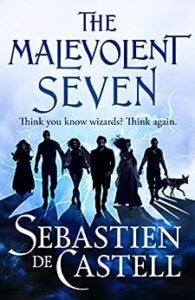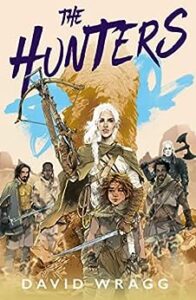The other day, I participated in a panel discussion alongside David Wragg, Sebastien de Castell, Marina Lostetter, and Jennifer Dewes (J.S. Dewes) for the SFF Addicts Podcast. We talked about developing character through dialogue.
![]()




All of the panelists are authors who create books with a wide-ranging cast of characters. Our initial focus was ensuring that each character’s point of view (POV) had a unique voice. My advice for achieving this is to examine a conversation between two characters and then strip the tags to see if you can distinguish who is speaking.
TIP ===> Remove any action and dialogue tags.
Without the tags, can you identify the speakers? If not, it suggests that your characters’ dialogue lacks distinction. This is crucial to shaping a character’s voice because our diverse backgrounds shape our vocabulary. A soldier, priest, journalist, politician or artist will all use different vocabulary and come from different mindsets.
For example, Marina’s fantasy novel Helm of Midnight features Krona Hirvath. Krona is a soldier and works with a team of Regulators, when they speak, it’s decidedly different than the way a civilian would speak.
Sebastien pointed out that if a character is talkative early on but suddenly becomes monosyllabic later, it can signal an issue. This shift can convey something is amiss between characters.
Jennifer emphasized the significance of slang and inside jokes in her work, given her characters’ close quarters on a ship at the universe’s edge. Shared slang reflects their growing intimacy. In her Divide series, the two POVs (captain and conscript) of Rake and Cavalon work so closely together to save humanity that their speech patterns and inside jokes reflect that as the series progresses.
Sebastian also says that he does a voice pass in his manuscript revision just to make sure that all of the povs do have a very different and distinctive voice.
Sebastien noted that characters justifying their actions are akin to pleading their case outside Heaven’s gates. They can be giving a speech or monologue of sorts that shows their world view.
We discussed pre-establishing distinct voices for POVs. I shared how I envisioned my character, Uncle Jimmy, in the magical Chinatown of “Ebony Gate,” using actor James Hong as inspiration. This aided me in crafting his dialogue.
TIP ===> Identify early the way the character is going to speak, and then be consistent throughout.
Corollary ⇒ What the character doesn’t say is just as important as what they do say.
In Sebastien’s Malevolent Seven, Cade and Corrigan are war mages who have fought side by side through many battles. When Corrigan wants Cade to keep his mouth shut, he just has to make a gesture, like putting his hand on Cade’s shoulder and that’s enough to signal to him that Cade needs to bite his tongue.
I noted that in East Asian culture dialogue can also show the social hierarchy between the characters. For example, the way a younger student might address an older student at a school in Asia is very different. In Ebony Gate, a conversation between Emiko Song and a shinigami, a death god, demonstrates their disparate societal roles. The shinigami is a bureacrat and uses formal speech and long sentences. Emiko, a mere mortal, responds politely despite her unease.
The shinigami’s eyes burned a fiery red, the light burning through me. He crooned, his voice caressing. “Yes. I believe you would be a sufficient anchor to close the portal.”
The energy in his hands flared, spewing icy cold power in purple waves that made my stomach flop over. His words sent a shiver down my spine. “Yes, I could bind you into the Gate, turn you into statuary. It would be lovely. You would spend the next millenia keeping your city safe. What do you think?”
The death god smiled at me. It was not a comforting smile.
I willed my hands to stay relaxed at my sides as I held his gaze. I gave myself a moment to quell the rising bile in my throat, passing it off like I was considering his offer. “As generous as your offer is, I’m afraid I must decline. Surely there is another way.”
The shinigami clapped his hands together and crushed the purple ball of energy between them. It made a low thump like someone dropping a heavy book and my ears popped. “As I said, my authority is limited. I cannot act with impunity in the mortal world. You shall be my agent. You know the city and your reputation precedes you. I know you will protect those under your aegis.”
OTHER TECHNICAL TIPS FOR DIALOGUE:
Sebastian shared a tip from the Marshall Plan for Novel Writing which is that dialogue should flow in the F-A-D direction: Feeling, Action, Desire. 
For instance, “Inspired, she reached for her pen, wanting to record her emotions before they faded.”
Compare with: “She wanted to record her emotions before they faded. She was inspired and reached for her pen.”
The FAD sequence ensures a natural rhythm for readers. Sebastien also does a voice pass during revisions to enhance distinctive voices for each POV.
Dave not only outlines, but outline where in the story the characters will have major arguments, signposting conflicts. His latest fantasy novel, The Hunters, has a great cast and I enjoyed Ree’s POV. Ree is a woman with a violent past. She’s older, jaded, and her speech style is more curt. In contrast, her 12 year old niece Javani is a hot mess and talks quite a lot.
I suggest blocking out the conversation by using dictation. Speaking is more natural and often results in more realistic dialogue. I use an app on my phone and just record dialogue as I’m walking the dog.
Lastly, if you’re writing something like an action scene, i suggest shorter sentences to speed things up. Fewer words means more negative space on the page for the eye to travel faster.
We also recommended works with strong dialogue examples. Marina suggested Terry Pratchett’s and Tendai Huchu’s books, praising Huchu’s young protagonist adopting a mature detective’s tone due to heavy responsibilities. In addition to T.L. Huchu’s Library of the Dead series (I am fan of the audio especially!) I recommended “Rivers of London” by Ben Aaronovitch, praising the distinctive protagonist Peter who rambles about architecture and jazz music.
The Youtube replay is here.


